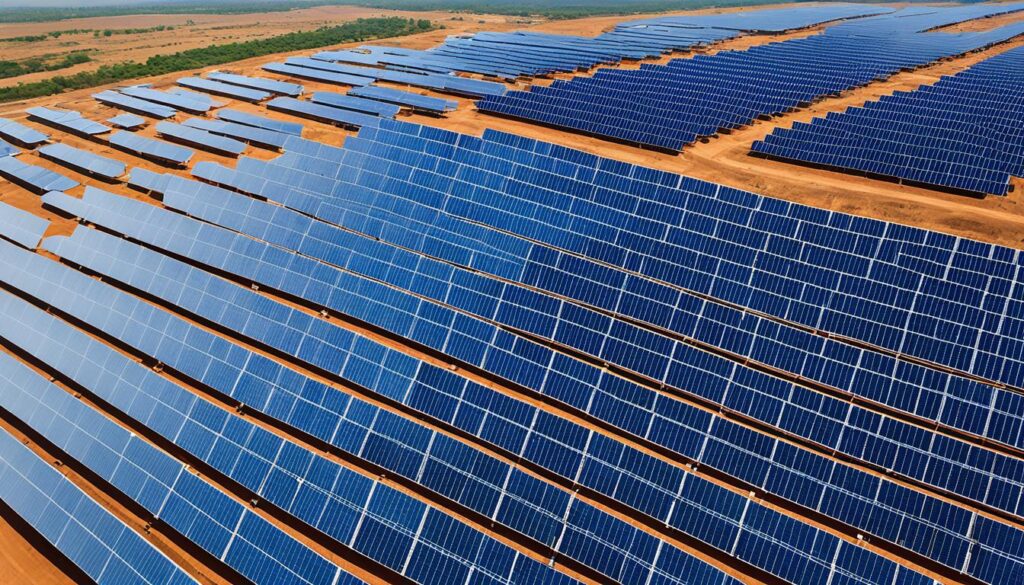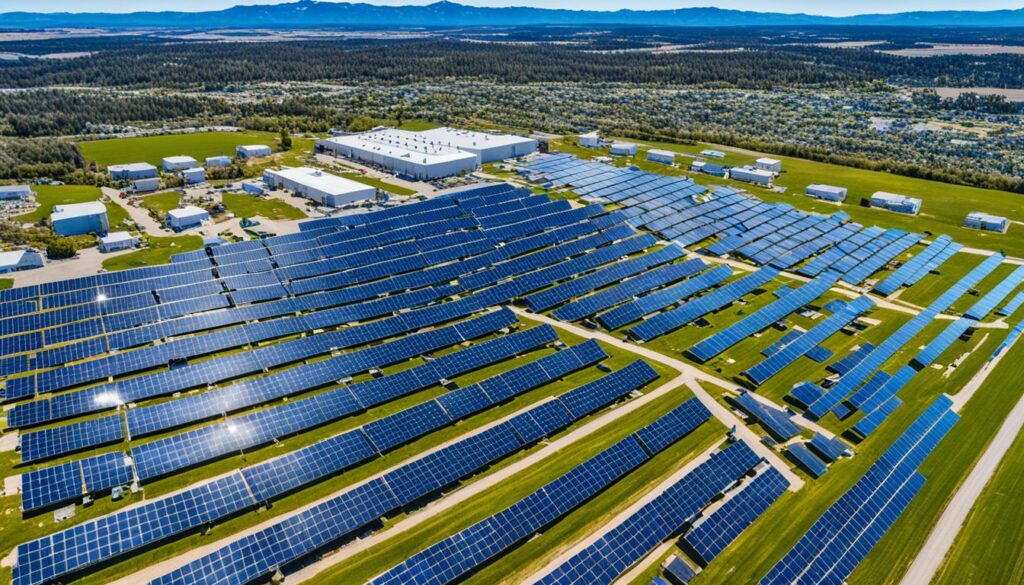India is taking significant strides towards a sustainable future with the construction of the largest solar power plant in india. The Bhadla Solar Park, located in Rajasthan, India, is a testament to India’s commitment to renewable energy and clean power generation.
The Bhadla Solar Park stands as a beacon of innovation and progress in the solar industry in India. With its massive size and impressive capacity, it is revolutionizing the way we harness solar energy and contribute towards a cleaner and greener environment.
Solar power plants such as Bhadla are essential in India’s transition to clean energy. Solar energy, being a renewable and abundant resource, offers a sustainable solution to power generation, reducing reliance on fossil fuels and minimizing carbon emissions.
This article will delve into the Bhadla Solar Park, exploring its strategic location and extensive spread, its environmental and economic impacts, advancements in solar technology, and solar energy’s role in transforming India’s renewable energy aspirations.
Key Takeaways:
- The Bhadla Solar Park is the india’s largest solar plant showcasing the country’s commitment to renewable energy.
- It is strategically located in Rajasthan, India, an area with high solar irradiance and low population density.
- The park has a vast expanse, covering an area of 14,000 acres.
- Bhadla Solar Park has a total installed capacity of 2,245 MW, contributing significantly to India’s clean energy portfolio.
- Solar power plants like Bhadla play a crucial role in reducing greenhouse gas emissions and promoting a sustainable future.
Unveiling The Bhadla Solar Park: Largest Solar Power Plant In India
The Bhadla Solar Park, located in the Thar Desert of Rajasthan, is the largest solar power plant in India. It covers an area of 14,000 acres and has a total installed capacity of 2,245 MW. The park was developed in multiple phases since 2015 and has achieved several capacity milestones.
Strategic Location and Extensive Spread
The Bhadla Solar Park is strategically located in a region with high solar irradiance and low population density, making it an ideal site for solar power generation. The Thar Desert receives ample sunlight throughout the year, which maximizes the efficiency of the solar panels. The extensive spread of the park allows for the installation of a large number of solar panels, resulting in substantial electricity generation.
Phased Development and Capacity Milestones
The development of the Bhadla Solar Park has occurred in multiple phases, with each phase adding to the park’s capacity. Since its establishment in 2015, the park has achieved several significant capacity milestones, solidifying its position as the largest solar power plant in India. The phased development approach has ensured a systematic and efficient expansion of the park’s capacity over time.
Environmental and Economic Impact
The Bhadla Solar Park has had a significant environmental impact by reducing greenhouse gas emissions. Solar power is a clean and renewable source of energy, minimizing the carbon footprint associated with traditional forms of electricity generation. Additionally, the park has contributed to the local economy by creating job opportunities and improving the electricity supply to the surrounding areas. The economic benefits of the solar park extend beyond the immediate vicinity through the development of solar energy infrastructure and the support of the clean energy industry.
| Key Features | Details |
|---|---|
| Location | Thar Desert, Rajasthan |
| Total Area | 14,000 acres |
| Installed Capacity | 2,245 MW |
| Development Timeline | Since 2015 |
| Environmental Impact | Reduction in greenhouse gas emissions |
| Economic Impact | Job creation and improved local electricity supply |
Advancements in Solar Technology at Bhadla
The Bhadla Solar Park is not only India’s largest solar power plant but also a hub of advancements in solar technology. The park has been at the forefront of innovative solutions to improve solar panel efficiency and overcome challenges posed by extreme weather conditions.
Innovations in Solar Panel Efficiency
One of the key areas of progress at Bhadla Solar Park is in solar panel efficiency. Engineers and researchers have been working tirelessly to develop more efficient photovoltaic cells and enhance panel designs. These innovations have resulted in improved energy generation and performance of the solar park, ultimately contributing to the overall efficiency of solar energy technology.
Managing Solar Farm Challenges in Extreme Weather
The Bhadla Solar Park faces unique challenges due to its location in the Thar Desert, where extreme weather conditions prevail. To ensure consistent and reliable power generation, the park has implemented effective measures to manage these challenges. Dust storms and high temperatures can negatively impact solar panels, reducing their efficiency. However, through the use of advanced cleaning techniques, resilient materials, and innovative cooling systems, the park has successfully mitigated the effects of extreme weather conditions.

| Advancements | Benefits |
|---|---|
| More efficient photovoltaic cells | – Increased energy generation |
| Improved panel designs | – Enhanced performance of the solar park |
| Advanced cleaning techniques | – Improved maintenance and longevity of panels |
| Resilient materials | – Enhanced durability in extreme weather conditions |
| Innovative cooling systems | – Effective heat dissipation, ensuring consistent power generation |
Solar Energy’s Role in India’s Renewable Energy Aspirations
Solar energy plays a crucial role in India’s ambitious plans for renewable energy. The country has set its sights on installing 100 GW of solar power capacity by 2022 through its National Solar Mission. This government initiative aims to harness the potential of solar energy to meet the growing electricity demands of a rapidly developing nation while reducing its dependence on fossil fuels.
National Solar Mission and Future Goals
The National Solar Mission is India’s flagship program for promoting solar energy adoption. Launched in 2010, it aims to achieve grid parity for solar power by 2022 and establish India as a global leader in solar energy production. The mission focuses on both grid-connected solar power projects and off-grid applications to ensure widespread access to clean and affordable energy across the country.
Looking ahead, India intends to continue expanding its solar capacity beyond 2022. The government aims to scale up solar power generation to 280 GW by 2030, a significant jump from the initial target of 100 GW. This aggressive approach demonstrates India’s commitment to transitioning to a sustainable and environmentally friendly energy mix.
The Contribution of Large Scale Solar Projects to India’s Green Energy Portfolio
Large scale solar projects, such as the Bhadla Solar Park, are instrumental in India’s journey towards achieving its renewable energy goals. These solar farm contribute significantly to the country’s green energy portfolio by harnessing the abundant solar resources available in various regions. The Bhadla Solar Park alone has an installed capacity of 2,245 MW, making it a significant player in India’s solar industry.
By generating clean electricity, large scale solar projects help India reduce its carbon footprint and mitigate the adverse impacts of climate change. They also enhance energy security by diversifying the energy mix and reducing dependence on imported fossil fuels. Moreover, these projects provide additional benefits to local communities, such as job creation and economic growth through the development and maintenance of solar infrastructure.
Key Players and Development Partnerships
The success of India’s solar energy sector is the result of collaboration between various key players and development partnerships. Leading solar companies and organizations have played a pivotal role in driving the growth of the industry, investing in research and development, and deploying innovative solar technologies. These entities have helped advance solar panel efficiency, reduce costs, and improve the overall performance of solar power plants.
Furthermore, development partnerships with international organizations and foreign governments have facilitated knowledge sharing, technical assistance, and financial support for India’s solar initiatives. Such collaborations have accelerated the scaling up of solar projects and provided valuable expertise in policy formulation, project management, and capacity building. Through these partnerships, India continues to strengthen its position as a global leader in solar energy.

